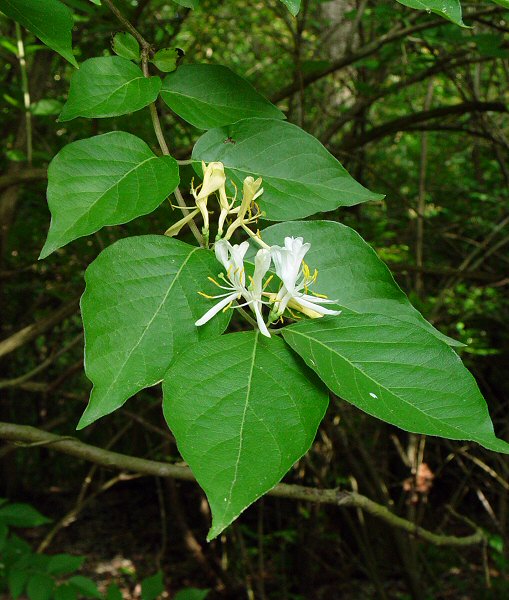Lonicera maackii (Rupr.) Maxim.
Amur Honeysuckle, Bush Honeysuckle

Introduced
CC = *
CW = 5
MOC = 30
© DETenaglia
Lonicera maackii (Rupr.) Maxim.Amur Honeysuckle, Bush Honeysuckle | |
 |
Introduced CC = * CW = 5 MOC = 30 |
© DETenaglia |
|
Family - Caprifoliaceae Habit - Shrub to 5.0 m tall, the main stems erect or ascending, self-supporting. Stems - Woody, multiple from base. Young twigs moderately to densely pubescent with short, curved, sometimes more or less tangled, unbranched hairs, the pith hollow. Older stems usually tan with faint longitudinal striping visible. Winter buds ovoid, hairy.
Leaves - Opposite, petiolate, simple. Petioles to 6 mm long, tomentose. Blades 3.5-9.5 cm long, 1.5-4.0 cm wide, elliptic to ovate-elliptic, angled or rounded to more commonly tapered at the base, tapered to a sharply pointed tip, the margins entire, the upper surface nearly glabrous, the lower surface and margins moderately pubescent with fine, mostly curved hairs, light green to pale green, not glaucous.
Inflorescence - Flowers paired in the axils of the leaves on current year's growth (first-year wood), each pair at the tip of a stalk 2-5 mm long (often appearing sessile at fruiting), the 2 bracts each 1-4 mm long, free, linear, hairy, the pair of bractlets on opposite sides of each flower 1/2 as long to about as long as the ovary, free, oblong-obovate to nearly circular.
Flowers - Calyces with stalked glands and long, straight hairs, the lobes 0.2-0.5 mm long, triangular. Corollas 15-25 mm long, strongly zygomorphic, divided about 1/2 of the way to the base into 5 more or less spreading lobes of about equal length, the upper lip shallowly 4-lobed, the lower lip 1-lobed, the tube not or very slightly swollen or pouched on the lower side near the base, white, turning yellow after pollination or with age. Stamens (5) and style exserted from the corolla, shorter than the corolla lobes, the style hairy. Filaments to 1.1 cm long, pubescent at base, glabrous near apex, white. Anthers yellow, to 6 mm long, 1.2 mm broad. Ovary free, inferior, with 2-5 locules, the placentation axile. Style 1 per flower, the stigma capitate. Ovules 1 to numerous per locule.
Fruits - Berries 4-7 mm in diameter, orangish red to red.
Flowering - April - June. Habitat - Forests, bases and ledges of bluffs, streambanks, fencerows, gardens, railroads, roadsides, and shaded, disturbed areas. Origin - Native to Asia. Lookalikes - Flowers are similar to those of several other members of the genus. This is the only common shrubby honeysuckle in Missouri. Vegetatively the plant can resemble native species such as wahoo (Euonymus atropurpureus). Other info. - This plant is probably the most noxious invasive shrub which plagues most parts of Missouri. It is found across the state, though is very under-collected because field botanists detest it and want nothing to do with it. When flowering it is easily identified through its shrubby habit and distinctive flowers, which are pure white when fresh but turn yellow with age. Identification in the vegetative state is not hard but requires a little more practice and study, which the images above are intended to facilitate. In particular, note the leaf shape and their opposite arrangement, lack of teeth on the leaf margins, the pale striping which is almost always present on older, woody stems, and the hollow pith. Photographs taken off the MKT Trail in Columbia, MO., 5-12-04 (DETenaglia); also at Weldon Spring Conservation Area, St. Charles County, MO, 9-26-2008, and Shaw Nature Reserve, Franklin County, MO, 5-17-2022 (SRTurner). |